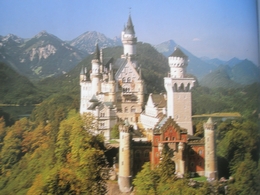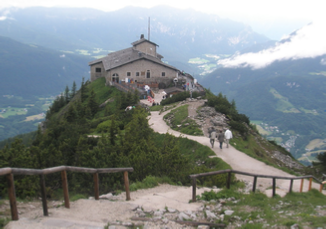



The Parish Church of St George the Martyr, Waterlooville

Neuschwanstein Castle
The latter being the Fairy Tale Castle you will have often seen in films and in tourist information, it was built by the young Bavarian King, Ludwig II who was only 18 years old when he came to the throne and was known as the fairy tale King. He loved music and the arts, but was not happy with the real world and had lost touch with reality, believing himself to be the successor and equal to the Sun King Louis XIV of France. The castles that he had built were of no practical use; they were just the realization of his dream land. Initially his castle building was harmless enough as he financed them from his own purse, but then they started to place a heavy burden on the state finances. In 1886 the government had him declared insane and replaced him with his brother; he was then taken to Berg castle on Lake Starnberg, where he was found drowned shortly afterwards along with his doctor. Many said he was murdered, others say he committed suicide, but the true answer for the mystery was never resolved.
There was quite a long steep uphill walk from the town to the Neuschwanstein castle, it was a good job there were plenty of seats on the way up as my friend who was with me found it hard work, so did I actually! So it was a good excuse for a beer when we finally got to the top. It was possible to get a horse and carriage up but we thought it would be good exercise, gluttons for punishment I think!! Once there the views from the castle were great. The inside was very interesting and the guide very informative, although we could have done with more time looking around as it all seemed a bit rushed.
Leaving Fussen we continued along the beautiful Alpine route to Birchtesgaden; it was on this drive we accidentally got onto a Austrian auto route without a vignette “pass” which won us both a large fine, Damn Sat Nav’s!!!
Sorry about the history lesson! But here is some more. As some of you may already know the area around Berchtesgaden was Adolf Hitler’s retreat, he bought a small house there in a small farming hamlet called Obersalzberg “upper salt mountain” in 1932 but he had rented it long before that. Then had it rebuilt during the height of his power in 1934 to a much larger and statelier one, built with a huge window overlooking Mount Untersberg making it grander and more in keeping with his position, this was known as the Berghof. It was here that he entertained many of his guests, Lloyd George, Duke and Duchess of Windsor, Neville Chamberlain and many others. It was on the terrace of the Berghof where we saw pictures of him and his guests in the newsreels of the time. Sorry young readers, but some of us are getting old and do remember those times.
The whole hamlet was then compulsory purchased by the Nazi party; but the occupants who had wanted to stay in their homes were harassed and forced to move out of the area by intimidation. Then many of Hitler’s high officials had houses built there, there was also an SS-
An article taken from a booklet by Berchtesgadener Landesstiftung printed in 1996 sums it all up very well: even 50 years after the most destructive war of all time the public’s interest in the role Obersalzberg played during the 3rd Reich has remained the same. Obersalzberg was no mountain paradise, no isle of oblivion far from the events of the world. Adolf Hitler lived here, a man whose unscrupulousness, craze for power and racial hatred led to war and destruction, as well as the killing of countless people. It was here that decisions were made that sealed the fate of millions of human beings and that still carry the repercussions throughout the world.
Obersalzberg area was heavily bombed near the end of the war and the buildings were completely blown up afterwards, all except the Eagle’s Nest. The site where all the buildings had been now has a museum called the Documentation Centre, here you can see by following a route round the building many pictures following the rise and fall of the Nazi party, I found it extremely interesting what with my liking for history.
The Eagle’s Nest which most people know about is actually the Kehlsteinhaus on the peak of the mountain, built under orders of Martin Borman and given to Hitler on his 50th birthday, but as he suffered from vertigo he very rarely lived in or used it. I gather that just building the road up to it was a feat of engineering.
It was the Americans who named it the Eagle’s Nest.
End of history lesson, the next instalment will have no facts and figures in it, “I think”. It will include a visit to Slovenia and the Dolomites, a most beautiful area.
Christine L Culley
The Eagle’s Nest
The Happy Wanderer - Still ambling around Europe
Heading east from the Maginot Line the first stop was by Lake Konstanz which borders Switzerland, Germany and Austria. It was not my cup of tea, far too commercial, but it did for a one night stop but I was quite happy to move the next morning and decided to give the area a wide berth in future.
Then following the German Alpine route, which was a lovely scenic drive to the next stop which was in the Western Bavarian Alps at Fussen. To the older members of the congregation it is very close to Oberammergau where we had a coach trip to 20 years ago for the Passion Play. Fussen is the home to the sightseeing attraction, the castles of Hohenschwangau and Neuschwanstein.
Festival Edition 2010

